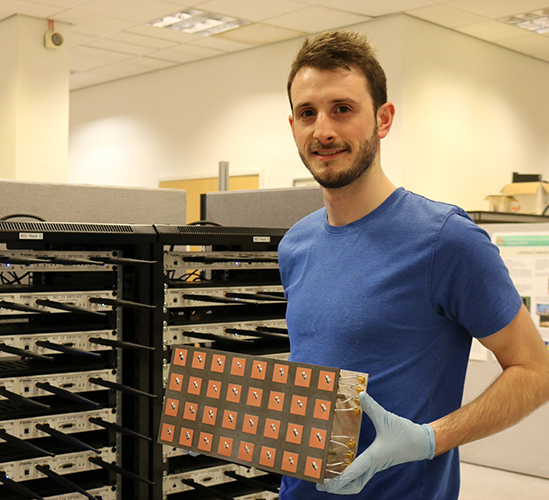
"Without the CDT, I simply would not be where I am right now. I was provided with so many opportunities that enabled me to grow both personally and professionally"
Alumni Profile: Paul Harris
What I'm doing now and how the CDT in Communications experience has helped my career
I am currently a Massive MIMO Platform Architect / Senior Systems Engineer at Cohere Technologies, a wireless communications startup based in Santa Clara, California. Cohere are developing and productizing a novel modulation scheme called Orthogonal Time Frequency Space (OTFS) which has the potential to provide for more stable and deterministic wireless performance when compared to OFDM.
Without the CDT, I simply would not be where I am right now. I was provided with so many opportunities that enabled me to grow both personally and professionally, from spending 3-months working in the USA with my sponsor, National Instruments, to being part of developing a world-first 128-antenna massive MIMO testbed. I honestly do not think I could have gained so much experience within 4 years elsewhere.
Why I chose the CDT route and what I gained from being part of the CDT in Communications
Whilst studying for my BEng in Electronic Engineering at the University of Portsmouth, I was fascinated by all things telecoms and knew I wanted to specialize in the subject. However, I also felt I wanted to remain practical as I enjoyed building, implementing and testing real systems. This made my choice of further study a difficult one, as heading down a wholly academic pathway did not appeal. The University of Bristol not only has a strong academic history in telecoms, but they also have excellent industrial links and thus a bridge to real-world applications with commercial interest. This combination was extremely important for me and greatly influenced my decision to join the CDT. The taught year offered by the CDT in Communications helped me to broaden my understanding and appreciation for a range of subject areas, before ultimately identifying a research project that suited me best.
PhD project topic
My project was titled ‘A Real-World Evaluation of Massive MIMO’ and consisted of a pragmatic investigation into the use of large-scale antenna arrays to increase wireless network capacity. Specifically, Massive MIMO involves the use of many tens or even hundreds of antennas at the wireless base station to serve more users simultaneously within a network on the same piece of radio spectrum. It does this by shaping the transmitted energy such that each user receives its own signal and the spatial interference between users is minimized. At the time I commenced my PhD, Massive MIMO was a hot topic in the academic literature, but empirical results were limited, and the feasibility of implementation scarcely explored. With the capacity demand placed upon wireless networks ever-increasing and radio spectrum availability diminishing, industry have considerable interest in the technology.
My PhD contributions formed through the development of a real-time Massive MIMO architecture in collaboration with Lund University and National Instruments. I spent a lot of time during the first half of my PhD constructing our 128-antenna implementation at Bristol, which included designing components such as a reconfigurable antenna array. I also spent 3 months as an intern at National Instruments in Austin, Texas, along with a coworker from Lund University, to learn more about the system architecture and contribute to the FPGA implementation.
In our first out-of-lab activities, I led teams from Bristol and Lund to set world records in spectral efficiency. This was an extremely exciting moment where we really felt like we were pushing the boundaries of what could be achieved in wireless communications. During the latter part of my PhD, I also worked with our partners at Lund University to conduct the world’s first Massive MIMO mobility testing in Sweden. We obtained some interesting results and were able to evaluate real-time performance with cars moving at speeds of up to 50 km/h. Finally, I subsequently acted as the technical lead on measurement trials with BT at their R&D headquarters in Ipswich.
I feel extremely fortunate to have had the opportunity to travel for a range of conferences, training courses, measurement trials and my internship with National Instruments, and thoroughly appreciate the support given to me by the CDT programme that enabled all of this. To name but a few places, I spent time in the USA, Australia, Portugal, France, Spain, Hungary and Sweden. I really did get to see the world and had such a great time doing it.
How the CDT training/secondments benefitted my PhD research
In addition to the technical training provided within the taught year, the soft skills training greatly improved my confidence when presenting to and managing audiences. I feel this is often a largely overlooked and extremely important part of being a well-rounded researcher or engineer and presenting at both the annual CDT conference and other external events helped me to refine the skill.
In my case, the secondment I undertook with National Instruments was invaluable and contributed greatly to the success of my research. Through working with the highly skilled and knowledgeable members of their Advanced Wireless Research Group, I learnt a lot about the practical challenges of implementation and some of the techniques required to successfully obtain real-time operation.
Five to ten-year plan
Over the next 5-10 years, I plan to continue building my experience in industry as a professional engineer, ideally working within R&D centric companies where I can contribute to novel and exciting projects.